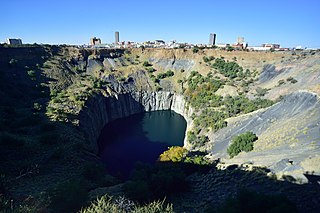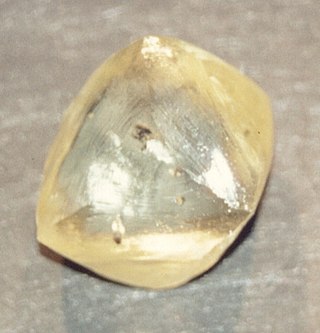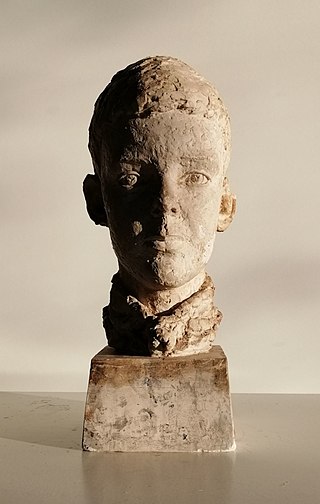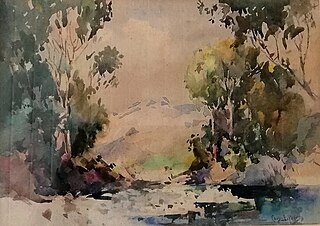Related Research Articles

Harry Frederick Oppenheimer OMSG was a prominent South African businessman, industrialist and philanthropist. Oppenheimer was often ranked as one of the wealthiest people in the world, and was considered South Africa's foremost industrialist for four decades. In 2004 he was voted 60th in the SABC3's Great South Africans.

Kimberley is the capital and largest city of the Northern Cape province of South Africa. It is located approximately 110 km east of the confluence of the Vaal and Orange Rivers. The city has considerable historical significance due to its diamond mining past and the siege during the Second Anglo-Boer war. British businessmen Cecil Rhodes and Barney Barnato made their fortunes in Kimberley, and Rhodes established the De Beers diamond company in the early days of the mining town.
Kimberley Boys' High School is a state secondary school or high school situated adjacent to the Honoured Dead Memorial, in the arc between Dalham and Memorial Roads, Kimberley, Northern Cape, South Africa – a site it has occupied since January 1914. The school was founded, along with what would become Kimberley Girls' High School, in 1887, under the name Kimberley Public Undenominational Schools. In July 1970 it gave rise to Kimberley Boys’ Junior School which in turn united with Belgravia Junior School in January 1977 to become what is today Kimberley Junior School.
Robert Hodgins was an English painter and printmaker.

Peter Clarke was a South African visual artist working across a broad spectrum of media. He was also a writer and poet.

The Cathedral Church of St Cyprian the Martyr, Kimberley, is the seat of the Bishop of the Kimberley and Kuruman, Anglican Church of Southern Africa. The building was dedicated in 1908, becoming a Cathedral when the Synod of Bishops mandated formation of the new Diocese of Kimberley and Kuruman in October 1911. The first Bishop, the Rt Revd Wilfrid Gore Browne, was enthroned there on 30 June 1912.

Du Toit's Pan, now usually Dutoitspan, is one of the earliest diamond mining camps at what is now Kimberley, South Africa. It was renamed Beaconsfield, which existed as a separate borough from Kimberley itself until Kimberley and Beaconsfield were amalgamated as the City of Kimberley in 1912.
The William Humphreys Art Gallery, in Kimberley, South Africa, was opened in 1952 and named after its principal benefactor, William Benbow Humphreys (1889–1965).
The Venerable Fr George Merwyn Lawson (1865–1945) served as archdeacon of Kuruman, 1913–1941, in the Anglican Diocese of Kimberley and Kuruman, and as Director of Missions for Griqualand West from 1903 until his death.
Harold Arthur Morris (1884–1977) was the fifth person to be awarded the Freedom of the City of Kimberley, South Africa, an honour conferred in 1967 in recognition of outstanding services to the City and the Northern Cape. Morris was born in Rondebosch, Cape Town, on 4 May 1884 and died in Kimberley aged 93 on 3 June 1977.
Richard Liversidge, naturalist, ornithologist and museum director, was born on 17 September 1926 in Blantyre, Nyasaland, and died on 15 September 2003 in Kimberley, South Africa.
Johannes Nicolas Malan, better known as Nico Malan, was an attorney, politician and administrator of the Province of the Cape of Good Hope of South Africa from 1960 to 1970. He was born on 8 August 1903 in Fort Beaufort and died there in 1981. In 1968 he received the Freedom of the City of Kimberley.
This is a list of the famous and notable people from Kimberley, Northern Cape, South Africa.

Moses Kottler (1896–1977) was a South African painter and sculptor. He is widely regarded, along with Anton van Wouw and Lippy Lipshitz, as one of the most important South African sculptors. This triumvirate had the distinction of also having excelled at using pictorial media; Lipshitz with monotypes and Van Wouw in painting and drawing. Kottler's work in oils earned him additional consideration as a painter.
Philip William Bawcombe, FRSA born in London in 1906 and died in 2000, was an industrial designer, inter alia for film studios, and official South African war artist during World War II, who also produced acclaimed collections of paintings illustrating the cities of Johannesburg and Kimberley, in South Africa, published as books in 1973 and 1976 respectively.
Walter Edward Westbrook was a South African artist who lived latterly in Kent, England. He was well known particularly for his watercolour landscapes inspired by the arid plains of the Northern Cape and Namibia, and later by the countryside of Kent and the English Channel. Westbrook was born in Pretoria in 1921 and lived in Kimberley for several decades before emigrating to England in the late 1990s. He died in Kent in 2015, aged 93.

Cape Ann Museum is an art and historical museum located in Gloucester, Massachusetts. Its collection and programming focuses on the artists and art colonies of Cape Ann, including the Rocky Neck Art Colony and the Folly Cove Designers. The museum's collection also features objects from Gloucester's fishing and maritime history, and granite quarrying history.

Baron Pieter van Reedevan Oudtshoorn was a senior official and Governor designate of the Dutch Cape Colony. He was appointed Governor of the Cape Colony in 1772 to succeed the deceased Governor Ryk Tulbagh but died at sea on his way to the Cape Colony to take up his post. The Western Cape town of Oudtshoorn is named after him. He is the progenitor of the van R(h)eede van Oudtshoorn family in South Africa.

Charles Ernest Peers was a South African artist.
Allerley Glossop (1870–1955) was a South African artist known particularly for her landscape and pastoral scenes.
References
- ↑ Hart, Robert. William Benbow Humphreys. In Now & Then: Newsletter of the Historical Society of Kimberley. June 2009.
- ↑ Hart, Robert. William Benbow Humphreys. In Now & Then: Newsletter of the Historical Society of Kimberley. June 2009.
- ↑ Hart, Robert. William Benbow Humphreys. In Now & Then: Newsletter of the Historical Society of Kimberley. June 2009.
- ↑ Hart, Robert. William Benbow Humphreys. In Now & Then: Newsletter of the Historical Society of Kimberley. June 2009.
- ↑ Hart, Robert. William Benbow Humphreys. In Now & Then: Newsletter of the Historical Society of Kimberley. June 2009.